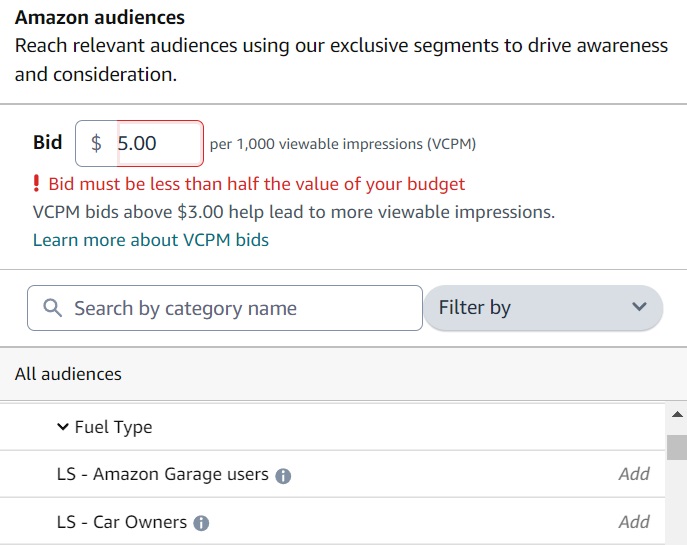Amazon, a name virtually synonymous with online retail, is now opening its doors to lead generation sectors.
It offers the chance to leverage unparalleled audience targeting capabilities.
Currently, the platform offers display-only advertising campaigns – but even with this limitation, it provides substantial opportunities for businesses to engage with potential customers.
In this article, we aim to explore the process of setting up advertisements on Amazon, their distinctiveness in today’s privacy-centric digital environment, and how they are transforming advertising strategies across various channels.
Please note that Amazon’s non-endemic advertising channel is still in its beta phase. We plan to keep this article updated as new features and information become available.
Understanding Amazon’s Non-Endemic Ads
Amazon’s non-endemic advertising allows businesses not selling directly on Amazon, such as lead generation advertisers, to target Amazon’s user base. The ad channel currently supports the following sectors:
- Travel.
- Automotive.
- Local Services.
- Restaurants.
- Education.
Advertisers set their bid levels at the audience level and combine them with creative assets at the campaign level, ensuring that bids do not exceed half of their daily budget.
Targeted audiences work on an “or” basis, allowing for broader reach.
 Screenshot from Amazon, January 2024
Screenshot from Amazon, January 2024When targeting Amazon’s audience for non-Amazon sellers, let’s say you select “Users using Amazon Garage” and “Mazda car enthusiasts.”
You will place a bid for each audience, and your campaign can target either group – not just users who fit into both categories.
It’s recommended to add multiple audiences to a single ad group only if you’re comfortable with all of them seeing the same ad. Otherwise, splitting them into different ad groups might be more effective.
Amazon also provides a market share preview of your audience, giving an overall number rather than a forecast based on your set budget.
This metric is particularly useful as it offers a clearer picture of the potential market you can reach.
 Screenshot from IMDB, January 2024
Screenshot from IMDB, January 2024These advertisements appear not only on Amazon but also across its third-party network, including platforms like Twitch and IMDB.
Advertisers can choose between cost per click (CPC) or cost per thousand impressions (vCPM) payment models.
From our experience, CPC suits those aiming for actual engagement, while vCPM might be better for those focused on brand visibility.
As of now, location targeting on Amazon is somewhat limited, but you can still target individuals, cities, states, or entire countries, with this service, currently exclusive to the US market.
It’s crucial to undergo and complete Amazon’s mandatory verification process to protect both advertisers and consumers.
Why This Channel Is Intriguing
For brands traditionally focused on Google or paid social lead generation, Amazon’s approach might seem unconventional.
At the core of Amazon’s advertising strength is its audience. In an era where privacy is paramount, Amazon has innovated to keep its audience targeting robust yet privacy-compliant.
Amazon’s platform provides in-depth insights into audience behaviors without targeting specific individuals, focusing instead on detailed group characteristics.
These can be based on product views, interactions with Amazon technologies or subsidiaries (like Whole Foods), and purchasing patterns.
Google Ads and Meta Ads can mislabel some sectors, and brands might find an easier time on Amazon.
For example, advertisers mentioning “no credit required” are sometimes incorrectly tagged as financial services, which can be an issue in the automotive sector.
Also, local services that blur the lines, like legal or wellness services, might find it easier to target appropriate audiences on Amazon due to its product-focused approach versus the idea-centric targeting on Google or Meta.
Amazon ads should be considered as part of an incremental advertising strategy.
If you’re allocating a portion of your budget for experimental campaigns, Amazon’s advertising platform is worth exploring, especially if you’re looking to balance your spending on visual content campaigns and target more strategically.
Setting Up Amazon Campaigns
The first crucial step in setting up an Amazon campaign is clearing the verification process.
Once that’s out of the way, the remaining steps are relatively straightforward. Registration should be done using the official legal name of your company.
If you’re setting up an account for a client, ensure they provide payment information in a timely manner. The campaign cannot start without this information.
The focus of campaign preparation involves selecting your audience and creating your ads. You can use Shutterstock images or upload your own for the creative component.
However, keep in mind the limited editing capabilities on the platform. Part of your ad creation will involve crafting text similar to a Google Display headline, capped at 90 characters.
After preparing your creative elements, you can select your audiences either manually or via search. Note that you can’t add them to your campaign or receive audience size forecasts if your bid is more than 50% of your daily budget.
Campaigns can be tailored to target leads (the only conversion event currently available), views, or clicks, with the choice influencing whether you opt for CPC or vCPM.
Why Non-Amazon Sellers Should Consider Amazon Ads
Amazon has cultivated one of the most robust audience pools available.
Although the campaigns are currently limited to display formats, they offer significant opportunities for reaching specific, sometimes hard-to-reach, audience segments.
The most promising opportunities lie in the automotive sector, particularly with Amazon Garage integration, and local services that can leverage Amazon’s insights into product purchasing patterns.
Between the extremely accessible auction prices and robust targeting, Amazon non-endemic display is a no-brainer to add to testing budgets.
More resources:
Featured Image: vijay0401/Shutterstock
